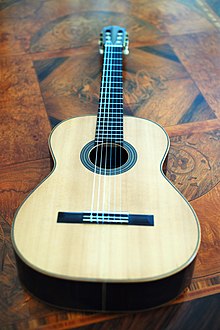Hermann Hauser (guitar maker)
Hermann Hauser I (born December 28, 1882 in Erding , † October 18, 1952 in Reisbach ) was a southern German guitar maker and guitarist .
Life
His father Josef Hauser built zithers , guitars and violins in his workshop from 1875 and was also active as a music dealer and zither composer. Hermann Hauser I began as a student of his father to build zithers. Like his older sister Marie, who worked as a lute and guitar teacher, Hermann Hauser I received his musical training from the Munich chamber virtuoso Josef Wimmer. From 1909 Hauser was active in the guitarist movement as a member of the "Guitarist Association Munich". From 1922 to 1926 Hauser I (1st third guitar) formed the Munich guitar quartet with Fritz Buek (2nd third guitar), Mela Feuerlein (primary guitar) and Hans Tempel (quint bass guitar) .
As a guitar maker and zither maker, Hermann Hauser I initially worked for five years in Munich at Braun & Hauser , the follow-up company to the business sold by his father.
The economic success through the sale of his guitars and zithers enabled Hermann Hauser I to acquire the Max Amberger company in 1921 , whose zithers he continued to build.
Hermann Hauser I had found his own style in guitar making by orienting himself on the constructions and construction technology of Antonio de Torres and developing them further with his knowledge. Between 1920 and 1930 he developed patented innovations in the area of ceiling constructions as well as innovations in the area of neck-body connections.
In 1937 the Spanish guitarist Andrés Segovia switched from a Manuel Ramírez to a Hermann Hauser guitar, which established the international breakthrough of the “Hermann Hauser” brand. The British guitarist and lute player Julian Bream played Hermann Hauser I guitars from 1936 and 1947, and around 1960 a Hauser guitar from Hermann Hauser II.
After Hermann Hauser's wife Emma died in 1943, he took over the string spinning mill she founded in Munich until 1944. In 1946 Hauser, suffering from asthma, moved to Reisbach in Lower Bavaria , where he married his second wife, Karolina Felizitas.
After the death of Hermann Hauser I, his son Hermann Hauser II (1911–1988), and later his grandson Hermann Hauser III, succeeded him. Since 2010 the daughter of Hermann Hauser III, Kathrin Hauser, has also worked as a guitar maker in the Reisbacher workshop.
legacy
The scientist Karl Huber wrote in 1995: "Ultimately and mainly it is thanks to the meeting of the Spanish virtuosos Llobet and Segovia and the Munich guitar maker Hermann Hauser (I) that the Torres guitar became the prototype of today's concert guitar."
The Hermann Hauser I guitar, which Andrés Segovia played from 1937 to 1962, can be seen in the Metropolitan Museum of Art in New York City.
Hermann Hauser III founded in 2005 together with the Munich-based entrepreneur and music producer Klaus Wolfgang Wildner the foundation of civil rights "Hermann Hauser Guitar Foundation"; the name of this internationally active cultural foundation goes back to Hermann Hauser I.
Web links
- Biography of Hermann Hauser I as part of the workshop history
- Website of the Hermann Hauser workshop, Reisbach
- Website of the Hermann Hauser Guitar Foundation, Munich
Individual evidence
- ^ A b c Ekkehard Schmoll: Festival concert for the 100th birthday of Hermann Hauser. In guitar & lute. Volume 5, Issue 2, 1983, p. 112 f.
- ↑ a b c Detlev Bork, Jörg Jewanski: Hauser. Article in: Music in Past and Present , Person Part, Volume 8, Kassel 2002, Sp. 879.
- ↑ a b Karl Huber, The revival of artistic guitar playing around 1900, Lisardo Verlag, 1995
- ↑ News. In: The guitar friend. No. 8-9, 1922, p. 58, No. 1-2, 1924, p. 11, and No. 1-2, 1951, p. 11.
- ↑ Thomas Drescher and Willibald Leo Frh. Lütgendorff: The violin and lute makers from the Middle Ages to the present. 3rd supplementary volume. Tutzing 1990.
- ^ Metropolitan Museum of Art: Andrés Segovia`s Hermann Hauser I guitar from 1937
- ↑ Süddeutsche Zeitung | About the establishment of the Hermann Hauser Guitarfoundation, 2005
| personal data | |
|---|---|
| SURNAME | Hauser, Hermann |
| ALTERNATIVE NAMES | Hauser, Hermann I. |
| BRIEF DESCRIPTION | South German guitar maker |
| DATE OF BIRTH | December 28, 1882 |
| PLACE OF BIRTH | Erding |
| DATE OF DEATH | October 18, 1952 |
| Place of death | Reisbach |

